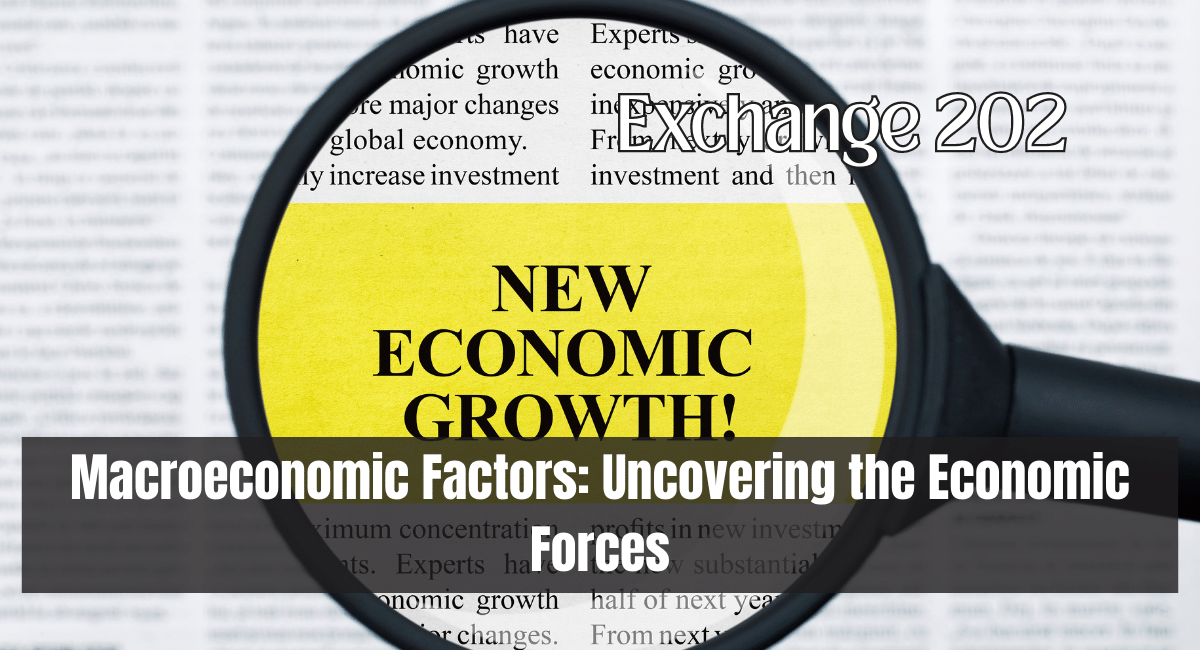The complicated web of economies is influenced by many factors beyond the scope of the individual firms and customers that make up that web. These factors, collectively referred to as macroeconomic factors, play an essential part in establishing the general state of an economy and its capacity for stability and growth through time. In this piece, we go into the realm of macroeconomic variables, discussing their relevance, the different sorts of macroeconomic factors, and the significant impact they have on the economic landscapes of the world.
Defining Macroeconomic Factors
The term “macroeconomic factors” refers to a wide variety of large-scale economic factors that affect the overall economic environment of a nation or region. Macroeconomic factors, on the other hand, investigate the collective behavior of economies as a whole, as opposed to microeconomic variables, which concentrate on individual entities such as homes and enterprises. Understanding and assessing these elements is vital for governments, legislators, corporations, investors, and individuals alike, as they provide insights into the more significant economic context in which decisions are made. These factors provide insights into the larger economic environment in which decisions are made.
Types of Macroeconomic Factors
- Gross Domestic Product (GDP): The gross domestic product is one of the most essential indicators of macroeconomic health. It is a measurement of the overall worth of all of the goods and services that were produced inside the borders of a country during a particular time period. A rise in GDP indicates that the economy is growing, whereas a fall may suggest that the economy is contracting.
- Inflation Rate: The general rise in the overall level of prices paid for goods and services over a period of time is referred to as inflation. It is generally agreed that a healthy level of inflation for an economy is one that encourages consumers to keep spending. However, hyperinflation can cause economies to become unstable and reduces consumers’ purchasing power.
- Unemployment Rate: The percentage of the unemployed labor force is a critical indicator of economic health. Low unemployment suggests a strong job market and robust economic activity, while high unemployment can indicate financial distress.
- Interest Rates: Central banks set interest rates, influencing borrowing costs and credit availability. Lower interest rates encourage borrowing and spending, stimulating economic growth, while higher rates can slow down spending and investment.
- Exchange Rates: The value of one currency in comparison to another is established by the current exchange rate. They have an effect on international trade and investment, in addition to the degree to which industries compete in foreign marketplaces.
- Trade Balance: The difference between a country’s exports and imports is what’s known as the trade balance for that country. A balance of trade in which exports are greater than imports can be helpful to economic growth, whereas a balance of trade that is in the red can result in trade deficits. A positive balance of trade occurs when exports are higher than imports.
- Government Fiscal Policy: Government spending, taxation, and budget deficits or surpluses influence economic activity. Expansionary fiscal policies involve increased government spending and lower taxes to stimulate demand, while contractionary guidelines aim to control inflation by reducing spending and raising taxes.
- Monetary Policy: Monetary policy is what central banks employ to control the amount of money in circulation as well as interest rates. Adjusting these elements is one of the primary ways that central banks work toward their goals of achieving economic stability, containing inflation, and fostering economic expansion.
The Interplay of Macroeconomic Factors
As a result of the linked nature of macroeconomic forces, changes in any one element can have widespread repercussions for the economy. For instance, if a central bank decides to raise interest rates, this may result in increased borrowing costs for companies and individuals, reducing consumer spending and company investment. This, in turn, can affect the growth of the GDP and the levels of employment. Alterations in currency exchange rates can also affect international trade, GDP, and work.
The Importance of Macroeconomic Analysis
- Policy Formulation: Governments and policymakers rely on macroeconomic analysis to formulate effective economic policies that foster growth, control inflation, and maintain stability.
- Investment Decision-Making: Investors use macroeconomic insights to gauge the overall health of economies and make informed decisions about asset allocation and investment strategies.
- Business Strategy: Businesses consider macroeconomic factors when deciding on expansion, hiring, and pricing strategies.
- Risk Assessment: Macroeconomic analysis helps identify potential risks and vulnerabilities within economies, enabling proactive risk mitigation.
- Global Market Dynamics: Understanding macroeconomic factors is crucial for navigating the complexities of global markets and responding to international economic shifts.
Challenges and Limitations
The examination of the macroeconomy is complicated and fraught with several obstacles. The data used in economic forecasting can be unpredictable, open to change, and impacted by events in the outside world. In addition, economies are complex systems that contain infinite variables, making it difficult to determine the influence of individual components.
Conclusion
The enormous ocean of economies can be thought of as being shaped by a series of undercurrents called macroeconomic forces. Their sway stretches well beyond the bounds of a single transaction, affecting millions of people’s lives and determining the courses of history for entire countries. Collectively, these factors offer a picture of the state of the economy and the path it will take going forward, from the growth of GDP and inflation to interest rates and trade balances. Knowing macroeconomic trends and their potential influence is not simply a matter of economic theory in an interconnected world; instead, it is a fundamental necessity for navigating the complicated tapestry of the global economy. In an interconnected world, knowing macroeconomic trends and their potential impact is not just a question of economic theory.
